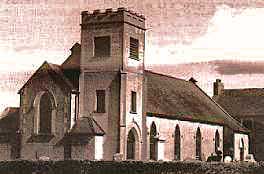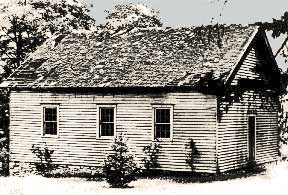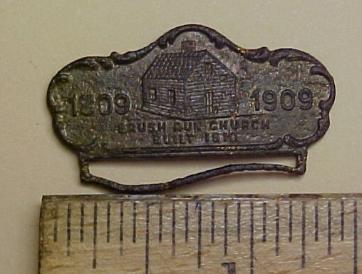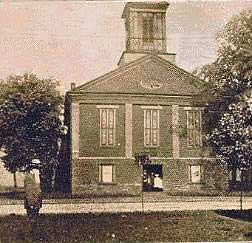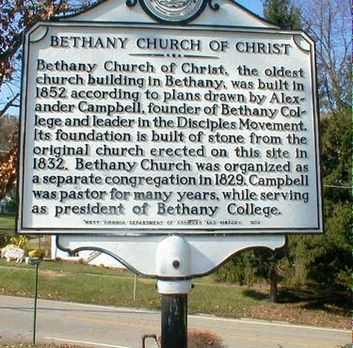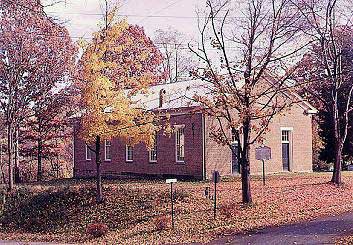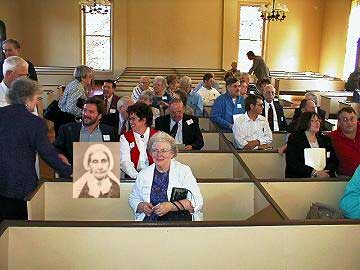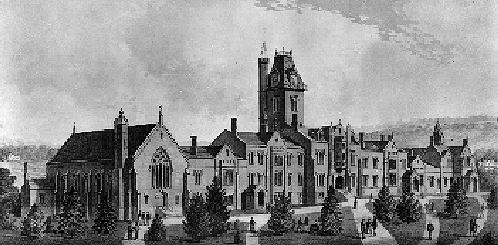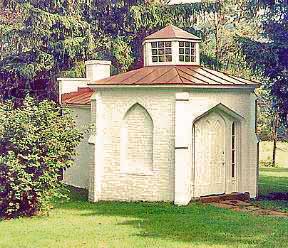Photo Survey of Bethany by Charles Dailey, 2000
The Presbyterian Church in Ahorey,
Northern Ireland where Thomas
Campbell preached before
moving to the United States.
The bell tower is not original.
Brush Run building after it had been
moved to Bethany for preservation.
Photo courtesy of Jim McElhaney, President of the
Brush Run Restoration Association.
Photo courtesy of Rich Bushta.
Earlier in life, Thomas Campbell had been a reliable and effective preacher among the Presbyterian Churches in Ireland. Prior to moving to the United States for his health, he had been minister of the Presbyterian Church in Ahorey, Northern Ireland.
When Thomas and his son Alexander Campbell could not find acceptance among the American churches for their view of Scripture as sole authority, they were forced to develop a meeting for their disciples.
A meeting house was built on Brush Run Creek in Washington County, PA. The first service was held here in 1811. In the summer of 2004, Rich Bushta of Clarksville, PA found a copper pin commemorating 100 years of the Brush Run Church. He located it in his yard with a metal detector. We appreciate Rick contacting us and supplying the photo of his find.
A writer in the 1885 Christian Standard had researched the original building and reported:
This frame, with the weather-boarding, was of good oak timber, and the building was thirty-five feet long, eighteen feet wide and thirteen feet high to the ceiling . . . .While the emerging group at Brush Run was moving toward an understanding of the church in Acts, students of Oregon history should be aware that Thomas Crawford McBride had already broken with the Stockton Valley Baptist Association in 1810. He was preaching the "ancient order" several years before the Campbells came to see it. McBride preached extensively in Tennessee and Missouri before riding to Oregon in 1847.
There is a link to a profile of Thomas Crawford McBride.
At this time, neither Thomas nor Alexander Campbell had identified the requirement of immersion in water as part of their relationship with God. However, they came to see that need and were immersed, even though they had been sprinkled earlier in life. Those rejecting immersion soon drifted away.
Wellsburg, WV Church of Christ
Dr. Leroy Garrett says,
In 1823 a second church was started, with 32 members from Brush Run being dismissed "to start a church of Christ," in nearby Wellsburg. These included Alexander Campbell and his wife Margaret, as well as youthful Selina Bakewell, who in just five more years was to be the second Mrs. Campbell. Campbell had immersed Selina and her mother in 1820.Alexander Campbell writes that he raised the $1,000 for the building in 1816. The old building still stands near Highway 2.
Millennial Harbinger, 1848, page 347Alexander had married the charming Margaret Brown and before long received the family farm from her father. It was located at Bethany, West Virginia, 12 miles to the west of Brush Run. Campbell expanded the land holding to about 2,000 acres.
Sign erected by the State of West Virginia at the
second church building constructed in Bethany.
On this land the town of Bethany and Bethany College were to be built.
This sign can be seen in the church building photo below. It is centered between the two doors.
In 1852 this brick building replaced an older stone building that had been used for 20 years. Some of the stones are incorporated into the foundation.
The interior ceiling is 18 feet at the front, and about 15 feet at the rear with an inclined floor. The building has been restored and can be used for meetings, as the photo below demonstrates.
Heat is from four pot-bellied stoves placed along the sides of the building. The raised speaker's platform is toward the street. Casually leaving the service was discourged as everyone in the building would see the person exit. There were no restrooms in the building.
Note the absence of steeples on the buildings.
The second Bethany Church Building
There is a narrow narthex or entryway just inside of the doors. It served to isolate the interior from the severe cold weather as people entered the building.
Mr. Campbell had the notion that seating singles separately would improve their interest in the service. Unmarried women sat on the speaker's left and single men sat on the other side while married couples occupied the center section. The boys carried knives as can be clearly seen by the carving on the backs of the benches on the men's side. The left door was generally for women, the right one for men.
Lois Dailey is sitting in Selina Campbell's pew.
One could almost feel her presence!
Campbell had married Selina following
the death of Margaret.
Singing sounds beautiful as the building resonates. It is a bit too live for recording purposes. Singing has always been a capella.
Lighting now comes from electric lights, but the fixtures in the photo originally held oil lamps.
Alexander Campbell was the usual speaker on the raised platform. It is doubtful if his father preached here as he died two years after the building was completed.
Alexander Campbell believed that a liberal arts education was best achieved in a rural setting, away from the contaminating influences of cities. He led in the establishment of this college on what had been his own property.
Bethany College, about 20 years after its founding.
To show Bethany College as it was in 1860, we have selected a lithograph by Strobridge and Company, made in that year. There have been many changes on the campus since then. The structures are similiar to the Gothic Revival architecture Campbell saw at the University of Glasgow in Scotland.
Link to photo at The University of Glasgow.The Bethany campus, in turn, served as a model for the construction of the first permanent building at Western Oregon University at Monmouth, Oregon. The construction, in 1872, was led by Thomas Franklin Campbell, who had lived at Alexander Campbell's home in Bethany.Link to a photo of Campbell Hall at Monmouth, Oregon.
The story of the Monmouth school is located on this link.
The profile of T. C. Campbell is on this link.
A. Campbell's Famous Hexagonal Study.
Bethany College became a model for other schools. According to Bethany President Duane Cummings, 209 colleges and 205 academies among the Stone-Campbell churches have modeled their progams after Bethany.
Unique among the Bethany buildings is Alexander Campbell's six-sided windowless brick study. It is located on the grounds at his home. The shape of the building was the inspiration for the design of the Christian Church in Camas, Washington and probably the large Tabernacle that once stood in Santa Cruz, California.
